- fuel supply, including a fuel tank, an electric fuel pump, a fuel filter, a fuel pressure regulator, pipelines and a fuel rail with injectors;
- air supply, which includes an air filter, throttle assembly, idle speed controller;
- catching fuel vapors, consisting of an adsorber, an adsorber purge valve and connecting pipelines.
Note. The vapor recovery system is described in a separate subsection (see «Evaporative Emission System»), since it only serves to fulfill environmental requirements to reduce toxicity.
The functional purpose of the fuel supply system is to ensure the supply of the required amount of fuel to the engine in all operating modes. The engine is equipped with an electronic control system with distributed fuel injection. In the distributed fuel injection system, the functions of mixture formation and dosing of the air-fuel mixture supply to the engine cylinders are separated: air is supplied by an air supply system consisting of a throttle assembly and an idle speed controller, and the amount of fuel required at each moment of engine operation is injected by injectors into the intake pipe. This control method makes it possible to ensure the optimal composition of the combustible mixture at each particular moment of engine operation, which allows obtaining maximum power with the lowest possible fuel consumption and low exhaust gas toxicity. Manages the fuel injection system (and the ignition system too) an electronic unit that continuously monitors, with the help of appropriate sensors, the engine load, the vehicle speed, the thermal state of the engine, and the optimal combustion process in the engine cylinders.
The main sensor for ensuring an optimal combustion process is oxygen concentration sensor in exhaust gases (Lambda probe). It is installed in the engine exhaust manifold and, together with the electronic unit and injectors, forms a circuit for adjusting the composition of the air-fuel mixture supplied to the engine. Based on the sensor signals, the engine control unit determines the amount of unburned oxygen in the exhaust gases and, accordingly, evaluates the optimal composition of the air-fuel mixture entering the engine cylinders at any given time. Having fixed the deviation of the composition from the optimal 1:14 (respectively fuel and air), which ensures the most efficient operation of the catalytic converter.
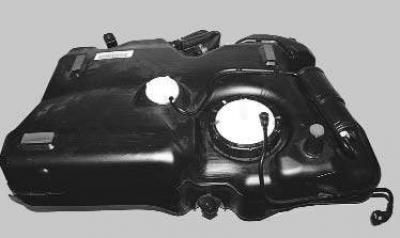
Fuel tank, molded from petrol-resistant plastic, is installed under the floor of the body in its rear part and is attached with four bolts. In order to prevent fuel vapor from entering the atmosphere, the tank is connected by a pipeline to the adsorber. An electric fuel pump is installed in a flanged hole at the top of the tank. From the pump, fuel is supplied to the fuel filter installed in the engine compartment on the bulkhead, and from there it enters the engine fuel rail mounted on the intake pipe. From the fuel rail, fuel is injected by injectors into the intake pipe.
Fuel lines power systems are tubes connecting various elements of the system.
Attention! It is forbidden to replace steel pipelines with hoses, copper or aluminum pipes, as only steel pipelines satisfy the conditions of high pressure and vibration.
Attention! The hoses of the power supply system are made using a special technology from oil and petrol resistant materials. Use of hoses other than those recommended may result in failure of the power system and, in some cases, fire.
Attention! In the connections of pipelines with elements of the power system, round sealing rings are used. The use of seals of a different design is prohibited.
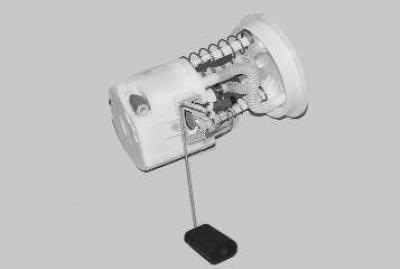
fuel pump module includes electric pump and fuel gauge sensor.
The fuel pump module provides fuel and is installed in the fuel tank, which reduces the possibility of vapor lock, since the fuel is supplied under pressure, not under vacuum.
The fuel pump is submersible, rotary type, with an electric drive. The non-separable pump cannot be repaired; if it fails, it must be replaced.
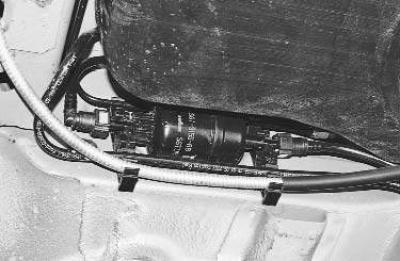
Fuel filter fine cleaning - full-flow, fixed in a bracket installed under the floor of the body in its rear part next to the fuel tank. The filter is non-separable, consists of a steel housing with a paper filter element.
fuel rail (pic. 5.14) is a cast hollow part with holes for installing injectors 1, with a flange for installing a fuel pressure regulator 5 and with a fitting for connecting a high-pressure fuel line. The injectors are sealed in the openings of the ramp and in the sockets of the intake pipe with rubber rings 4 and secured with spring clips 3. A fuel pressure regulator is attached to the rail flange with a fixing bracket, to which the fuel drain pipeline is connected. The rail assembly with the injectors and the regulator is inserted with the injector shanks into the holes of the inlet pipe and secured with two bolts.
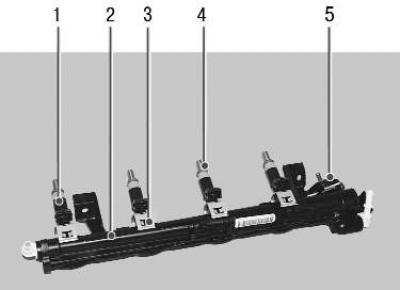
Pic. 5.14. Fuel rail: 1 - nozzle; 2 - ramp; 3 - nozzle retainer; 4 - nozzle sealing ring; 5 - fuel pressure regulator
nozzles (pic. 5.15) attached to the ramp from which fuel is supplied to them, and with their atomizers they enter the openings of the intake pipe. In the openings of the ramp and the inlet pipe, the nozzles are sealed with rubber sealing rings 1 and 3. The nozzle is designed for metered fuel injection into the engine cylinder and is a high-precision electromechanical valve. Pressurized fuel flows from the rail through channels inside the nozzle body to the shut-off valve. A spring compresses the check valve needle against the taper hole in the atomizer plate, keeping the valve in the closed position. The voltage supplied from the engine control unit through plug-in terminals 2 to the injector solenoid winding creates a magnetic field in it, which draws the core together with the shut-off valve needle into the solenoid. The conical annular hole in the atomizer plate opens and fuel is injected through the diffuser of the atomizer body into the inlet channel of the cylinder head and further into the engine cylinder. After the termination of the electrical impulse, the spring returns the core and the needle of the shut-off valve to its original state - the valve is closed. The amount of fuel injected by the injector depends on the duration of the electrical impulse.
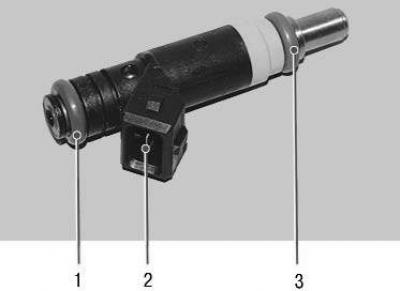
.Pic. 5.15 Nozzle of the fuel injection system: 1 - top sealing ring; 2 - plug terminals of the electromagnet winding; 3 - lower sealing ring
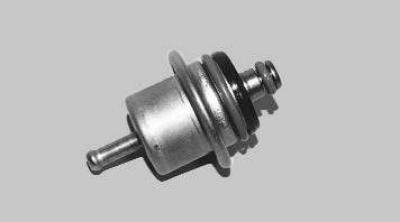
Fuel pressure control, mounted on the fuel rail, maintains a constant fuel pressure in the central channel of the rail in all engine operating modes. The regulation of the pressure of the fuel supplied to the injectors is based on the principle of monitoring the value of the pressure drop in the rail and the intake pipe, which under any conditions should be at least 300 kPa (3.0 kgf/cm2). The electric fuel pump supply is greater than necessary to keep the system working. Therefore, when the engine is running with the help of a pressure regulator, part of the fuel is constantly drained through the return pipe into the fuel tank. Depending on the vacuum in the intake pipe, the pressure regulator reduces or increases the discharge of excess fuel, maintaining a constant pressure in the rail.
The pressure regulator is a closed cavity divided by a diaphragm into vacuum and fuel chambers.
The vacuum chamber communicates through a vacuum hose with the engine inlet pipe, the fuel chamber communicates through a channel in the regulator housing with the fuel rail cavity. During engine operation under the action of a spring, the regulator valve is closed if the pressure drop in the intake pipe and the fuel rail is not more than 0.3 MPa. There is no backflow of fuel - the pressure in the fuel line begins to rise. With pressure drop over 300 kPa (3.0 kgf/cm2) the diaphragm of the regulator bends and a gap is formed between the valve and its seat, through which excess fuel is drained into another channel of the regulator connected to the drain pipeline - the pressure decreases. When the engine load increases, operating at a wide throttle opening, fuel consumption increases and the pressure in the fuel rail drops. At the same time, the vacuum in the intake pipe is reduced. The spring presses the pressure regulator valve to the seat, the fuel drain into the fuel tank stops - the pressure rises. These processes are repeated continuously, as a result of which a constant pressure is maintained in the fuel rail.
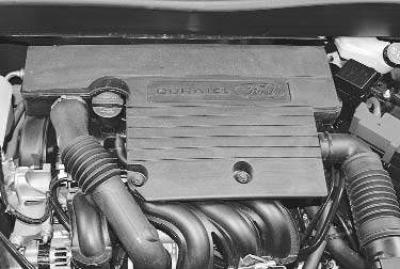
The air filter is installed in the engine compartment.
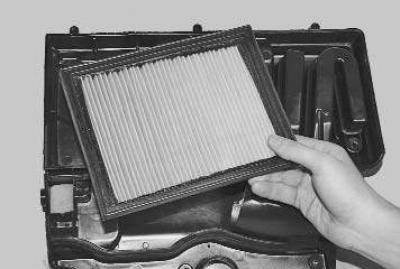
The filter element of the air filter is paper, flat, with a large area of the filtering surface.
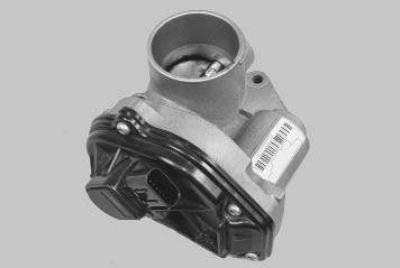
Throttle assembly is an electronic control device and serves to change the amount of main air supplied to the engine intake system. It is installed on the inlet flange of the inlet pipe. A molded rubber sleeve is put on the inlet pipe of the throttle assembly, fixed with a clamp and connecting the throttle assembly with the air filter.
The throttle assembly includes a throttle position sensor, an absolute pressure sensor and a throttle control stepper motor. There is no mechanical connection between the throttle assembly and the throttle control pedal. So-called «electronic» The throttle pedal sends information about the degree of depression on the pedal to the electronic engine control unit, which, in turn, takes into account the vehicle speed, gear engaged, engine load and engine speed, opens the throttle.
Vapor recovery system fuel prevents the release of fuel vapors from the power supply system into the atmosphere, which adversely affect the environment.
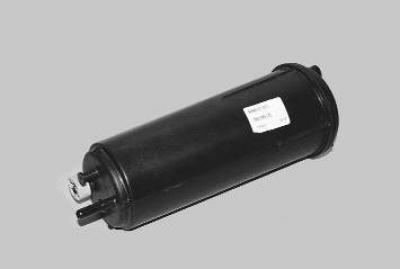
The system uses the method of absorption of fuel vapors by a coal adsorber. It is mounted on the fuel tank and connected to it by a pipeline and a purge valve.
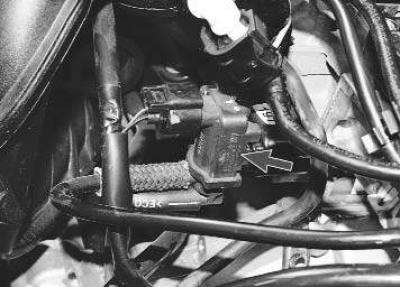
In the engine compartment on the cylinder head there is an adsorber purge solenoid valve, which, at the signal of the engine control unit, switches the operating modes of the system.
Fuel vapors from the fuel tank are constantly discharged through the pipeline and accumulate in the adsorber filled with activated carbon (adsorbent). When the engine is running, it regenerates (recovery) adsorbent by purging the adsorber with fresh air entering the system under the action of vacuum, transmitted through the pipeline from the diffuser of the throttle assembly to the adsorber cavity when the purge valve is opened. The controller regulates the degree of purge of the adsorber depending on the mode of operation of the engine, giving a signal to the valve with a variable pulse frequency.
Fuel vapor from the adsorber through the pipeline enters the engine intake pipe and burns in the cylinders.
Malfunctions of the evaporative emission system entail idle instability, engine shutdown, increased toxicity of exhaust gases and deterioration in driving performance of the vehicle.
Visitor comments